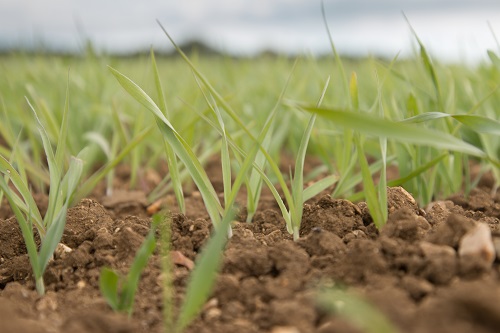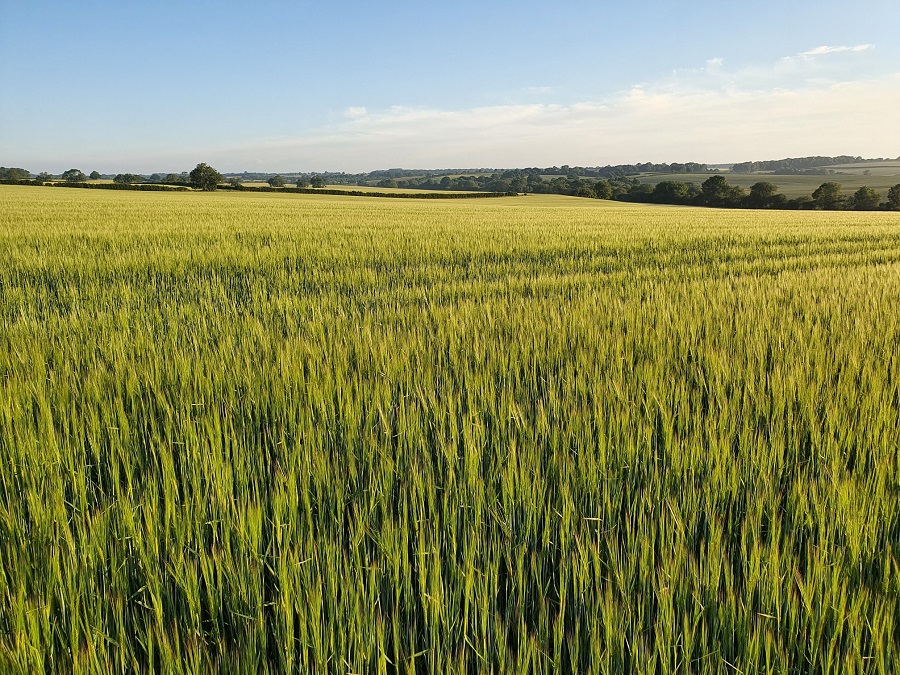Spring barley destined for Budweiser is helping an estate in Buckinghamshire deliver wider sustainability benefits. CPM finds out how.
As a continental type, Explorer develops at an unbelievable pace.
By Rob Jones
There’s much to like about a premium barley which yields well on difficult ground, ill-suited to traditional malting production, all for an input cost of less than £65/tonne. The Budweiser barley-growing maths certainly add-up for farm manager, Chris Singer and his team at the Carington Estate in Buckinghamshire.
Even though the margin is promising, it’s sustainability that is the main reason the estate routinely grow around 200ha of Explorer on contract for the leading brewer in their diverse, 1400ha cereal-based rotation.

Spring barley was introduced into the rotation in 2013 to help manage blackgrass on the farm.
“It’s good to have a secure local market, especially one offering a guaranteed minimum 2021 premium of £15/t for a 1.75-2.05% nitrogen specification in such uncertain malting market times,” says Chris.
Having a spring crop that can be planted relatively late but still reach harvest ahead of wheat is a real boon for the three-man estate team, who also lamb 400 mule ewes and deal with cropping spread across 50 miles of the county.
“We introduced spring barley into our rotation in 2013 to help manage blackgrass. Ground too strong for malting left us no option other than commodity feed growing, which wasn’t ideal on our yield-limited land,” says Chris.
“Our real problem was having to harvest into Sept. We deliberately run only one set of kit and wheat has to take the priority at combining. That together with the distances involved meant that too much of the barley could be on the floor by the time we were able to get to it.
“It’s a completely different story with Explorer which we started growing in 2015, shortly after the Budweiser contract was launched. The 30ha we grew initially was enough to convince us of its fit here and it’s been an important part of our rotation ever since.
“As a continental type, Explorer develops at an unbelievable pace. We sow it in the second half of March and harvest from the end of July. Even so, we’ve been averaging almost exactly the same yield as we previously achieved with feed varieties – a little over 6t/ha. As we no longer grow winter barley or oilseed rape, it’s the first crop we combine,” he says.
“We’ve been staggered where the yield comes from on our difficult, thin ground. And every load we’ve grown has made the Budweiser spec.”
From a wider sustainability standpoint, Chris and his Agrii agronomist, Steve Baker, find Explorer especially well-suited to the sort of seasons the UK has been experiencing of late. The variety’s growth habit means they can hold-off drilling until well into April, if necessary, to let the ground dry out and warm-up from a wet winter.
As the crop is already well along in its development by the end of May, it avoids the grain set problems that can bedevil other spring barley varieties in a dry, early summer. What’s more, it’s hugely competitive with grassweeds.
“The crop didn’t go in until 20 April in 2018 and it still delivered 5.5t/ha,” Steve points out. “This sort of resilience really helps these days. Chris and I haven’t found the variety any more demanding – or costly – to grow than feed barley. Having said that, we’ve learnt a good bit about how to make the most of it over the years.
“We make sure the seed goes into the sort of conditions that support its rapid growth and development, so we don’t drill before the middle of March. We’ve sown at 350-375 seeds/m2 and have used up to 140kgN/ha to date,” explains Steve.
“Where crops are now going in behind two-year AB15 stewardship legume mixes, in particular, we’re looking to cut back on the nitrogen while upping the sowing rate to 400 seeds/m2. This should keep yields up and grain nitrogen comfortably within spec.
“We typically apply half the nitrogen with a balance of fresh available phosphate, potash and sulphur (as Agrii-Start NPK) down the spout with the seed using a Horsch Avatar, and the rest as soon as we can see the tramlines. With phosphate lock-up a particular problem on much of the ground, the phosphate protection provided by the specialist fertiliser’s P-Reserve coating is essential,” he believes.
Having progressively reduced cultivations over the past five years, the Carington Estate team either direct drill their Explorer into winter covers, which have been burnt off using glyphosate, or following a shallow pass with a Horsch Terrano. To deal with resistant wild oats, Avadex (triallate) granules are the ‘go-to’ pre-emergence, with a sulfonylurea/fluroxypyr mix for broadleaf weeds with the T1 fungicide.
“Ahead of a prothioconazole-based T1 and the crop’s main PGR, we always apply Adjust (chlormequat) with manganese at GS12 or GS13 to manipulate root and shoot growth for a solid base to build on. We’ve found early growth regulation makes all the difference with something that goes through its growth stages as fast as Explorer.”
“The farm has variable soil pH – with nearly 5.0 at one extreme and up to 8.0 at the other. This means we include trace elements with every spray to counter availability problems,” adds Steve. “These are vital to maintain the best balance of nutrition throughout the season across our land which is so spread out that we have to make the most of the sprayer at every visit.
“Another thing we’ve learned with Explorer and the logistics of our business is the importance of combining our crops as soon as they’re ready. Having them all together right at the start of our harvest ensures the combine is in just the right place to go without any delay.”
Although Explorer-growing has proved valuable in smothering blackgrass on the estate’s heavier northern land, for logistics reasons – more than anything else – it’s currently largely concentrated on the thinner southern ground. This has meant it has been grown for four consecutive seasons on some fields.
To maximise the sustainability of this approach, the team have been ‘playing around’ with different winter cover crops in recent years; the early harvest giving a good window for the most-timely autumn establishment.
The jury is still very much out on the best mix, adds Chris. Their initial combination of mustard with the inevitable spring barley volunteers proved very useful. But, more recently, black oats and vetch have been less of a success in both drying out the land and structuring the soil.
“Cover cropping plays a valuable role in our effort to put much more into the land we’ve taken back in-hand. Especially so when it’s integrated into the commercial shoot we run and generates extra revenue from a local store-lamb grazing arrangement.
“The maize and short-term leys we now have in our rotation in an arrangement with a neighbouring dairy unit work well for our soil improvement efforts, as does the straw-for muck swap we have alongside this. The liquid digestate we take also helps, although the supply is more variable than we’d like. Looking ahead, we’re keen to try applying this to growing crops in the spring as well as under-sowing winter cereals with clover to provide continuous cover in the arable rotation,” he says.
“Explorer continues to be the mainstay of our spring cropping alongside 120ha of spring wheat grown on a seed contract and 60ha of maize for silage. It does us well, competing strongly with second wheats in its margins and giving the workload spread so essential to our regime.
“We’ll be putting in an extra 80ha of spring barley this spring to replace wheat that rotted in the wet on some of our heavier land. Providing we can make the logistics fit, this may well also be Explorer. Apart from anything else, it will give us the greatest possible time for the ground to dry out and restructure ahead of drilling.”




